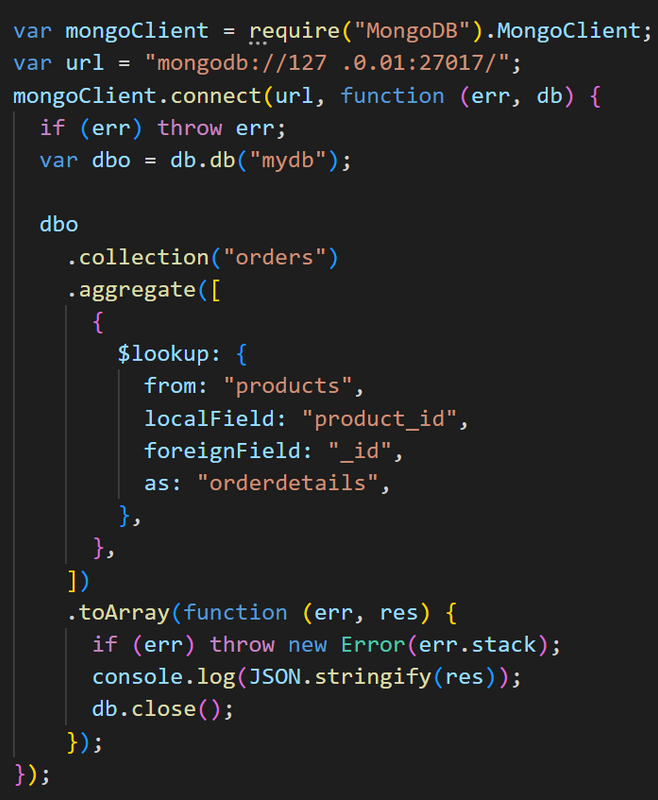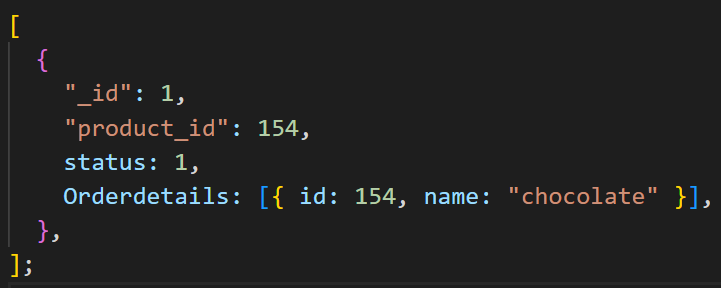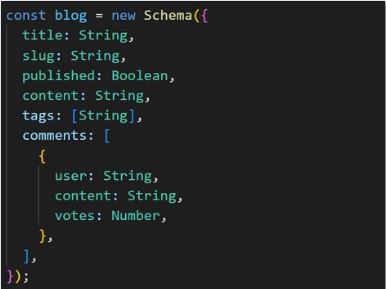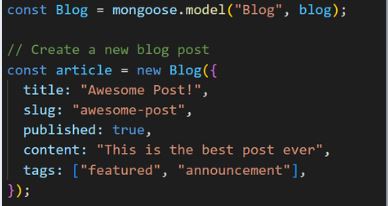30 Important Questions for MongoDB Interview
By Javascript Diary
April 3, 2023
Question: 1 - What is MongoDB?
Answer:
MongoDB is an open-source document-oriented database that is designed to store a large scale of data and also allows you to work with that data very efficiently. It is categorized under the NoSQL (Not only SQL) database because the storage and retrieval of data in the MongoDB are not in the form of tables
Question: 2 - What is NoSQL (Not only SQL)?
Answer:
NoSQL database stores data in a single data format, including a JSON document rather than the traditional table structure of relational databases. This non-relational database architecture does not really need a structure, it can quickly handle massive, often unorganized data sets.
Question: 3 - What are the features of MongoDB?
Answer:
- Document Oriented: stores all the data in the form of documents instead of tables like in RDBMS.
- Schema-less Database: it can hold multiple documents and these documents may consist of the different numbers of fields, content, and size.
- Scalability: provides horizontal scalability with the help of a mechanism known as sharding. Sharding refers to the process of distributing data on multiple servers.
- High availability: through built-in replication and failover.
- Aggregation: MongoDB also allows to perform operations on the grouped data and get a single result or computed result.
Question: 4 - When to use MongoDB?
Answer:
You should use MongoDB when you are building internet and business applications that need to evolve quickly and scale elegantly.
Question: 5 - What is Indexing in MongoDB?
Answer:
MongoDB uses indexing in order to make the query processing more efficient. if there is no indexing, then the mongoDB must see every document in the collection and retrieve only documents that match the query.
Indexes are a special data structure that stores some information related to the documents such that it becomes easy for MongoDB to find the right data file.
Syntax to create index
db.collection_name.createIndex({Key:1})
Drop index
db.name_of_collection.dropIndex( Key:1})
It deletes one index at a time
Multiple drop
dropIndexes ( ) method
Description of all indexes
db.<name-of-Collection>.getIndexes ( );
Returns an array that holds a list of documents that identify and describe the existing indexes on the collection
Data Types in MongoDB
Staring, Integer, Boolean, Double, Array, Object Data, code, Regular expression, Null
Syntax to store data in array
{ Memberships: [“mem1”, “mem2”] }
Syntax to store data in object
{ address: {“street: “4th main”, city:”bangalore”, country: “India” }}
Question: 6 - Can you tell the steps of installing MongoDB?
Answer:
Step 1: Download mongoDB installer from official website and after running installer, create folder called data in C/ MongoDB/
Step 2: Create folder called log in C/MongoDB/
Step 3: Inside the data folder create folder DB where all the data will be stored.
Step 4: cd.. to mongo/bin/ in CMD ( command Line )
Add require flags to this folder
(a)
— directory per db – -dbpath C:\mongodb\data\db
— logpath C:\mongoDB\log\mongo.log
— log append –rest –install
These Flags allow us to run mongodb as a service.
Step 5: to start, mongoDB service use blow command net start mongoDB
Step 6: to run Mongo shell just type Mongo in command line in bin directory: $ Mongo
Question: 7 - What are some MongoDB commands?
Answer:
- To create database: $ use < Database-name >
- To check current database: DB
- Use database by creating a user
$ db.createuser({user : “root”, pwd : “123”, roles : [“readwrite, “dbAdmin”] }): - Create collection:
$ db.createCollection (‘collection_name’); - insert data:
$db.customers.insert({first_name:”ABC”,last_name:”doe”}); - Show record:
$db.colection_name.find( ); - Add multiple record using array
$db.customer.insert([{ first_name: ‘Albert’, last_name : ‘Einstein’},{
fisrt_name: ‘smith’, last_name: “xyz”}]); - Update in mongoDB
syntax: db.collection.update({matches}, {what to replace});
db.customers.update({first_name: “smith”}, {first_name: ” smith”,
last_name : “Doe”, gender: “male”});
It will replace the whole record that matches with first_name smith. Also, if we notice previous query, we were passing first_name and last_name along with the gender, you might have thought we could have done something like below;
$ db.customers.update ({first_name : “smith”}, {gender: “male”}):
But by doing this, this will replace the complete document of your matches.
Now if you retrieve the data then you will just find { gender: “male”}. You will lose first_name and last_name.
Solution: db.customers.update ({ first_name : “Steve},{$ set:{ gender “male”}});
Question: 8 - What are operators in MongoDB?
Answer:
- inc operator used to increment the number value
$ db.customers.update ({first_name : “steven”}, {$ inc: {age :5}}); - unset operator it is used to remove the field record
db.customers.update({first_name: “steven”},{$unset : {age:1}}); - upsert parameter It insert record if there is no match in collection
db.customers.update({first_name : “ABC”, first_name :”ABC”, last_name:
“samson”}, {$upsert : true});
Now Above query will add new record - $or (OR) operator
db.customers.find ($or:[{first_name: “ABC”}, {first_name: “XYZ”}]); - greater than and less than operator $gt and $lt
(a) Find record where age is less than 40
$db.customers.find({age :{ $It :40 }});
(b) Find record where age is greater than 40
$ db.customers.find ({age :{$gt :40}});
Question: 9 - Write a query to rename a column?
Answer:
Suppose if you want to rename a column like gender to sex then to do this, you can use rename.operator with update function.
db.customers.update({ first_name : “steven”}, {$ rename {“gender”:”sex”}});
Question: 10 - How to remove document?
Answer:
Question: 11 - Give an example of " justone" parameter"
Answer:
db.customers.remove({first_name: “steven”}, {justone: true});
so the above line will remove the only first matched record in the document
Question: 12 - What is Collection?
Answer:
Question: 13 - What is the limit of a document in collection?
Answer:
Question: 14 - What is capped collection?
Answer:
Fixed size collections that support high-throughput operations.
How to Create capped collection:
To create a capped collection, use the normal create collection command but with capped option as true and specifying the maximum size of collection in bytes
$db.createcollection(“capped collection”, {capped:true, size:10000})
In addition to collection size we can also limit the number of documents in collection using max parameters.
$ db.createcollection (“capped collection” {capped:true, size:10000,
max:1000});
If you want to check whether a collection is capped or not , use the
following isCapped() command:
$ db.collection_name.isCapped( )
If there is an existing collection which you are planning to convert to capped
$ db.run command ({ “convert to capped”: “post”,size:1000})
This code would convert our existing collection to a capped collection
Question: 15 - Can you explain how mongoDB is better than RDBMS?
Answer:
- It is faster than a traditional database because there is no support for complex joins in MongoDB. In RDBMS, complex joins are difficult to understand and take too much time to execute.
- MongoDB does not care for schema and is ready to handle unstructured and huge amounts of data.
- easy to learn and scalable ( horizontally scalable )
- a flexible schema makes it easy to evolve.
Question:16 Does mongoDB supports joins?
Answer:
MongoDB is not a relational database but you can perform a left outer join by using the $lookup stage.
- the $lookup stage lets you specify which collection you want to join with the current collection and which fields that should match.
Consider you have a “orders” collection and a product collection
Orders
[ { _id : 1, product _ id : 154, status :1}]
Products
[
{ _id:154, name : ‘chocolate Heaven’},
{ _id: 155, name : ‘tasty lemons’},
{ _id: 156, name , ‘vanilla dreams’}
]
join the matching “products” document (s) to the orders collection


Question: 17 - What is aggregation in MongoDB?
Answer:
Aggregation is a way of processing a large number of documents in a collection by means of passing them through different stages.
The stages make up what is known as a pipeline. The stages in a pipeline can filter, sort, group, reshape and modify documents that pass through the pipeline.
One of the most common use case of Aggregation is to calculate values for groups of documents.
Note: The map-reduce framework on MongoDB is an old version of the aggregation framework and much more complex to use. MongoDB has deprecated the map-reduce.
Question: 18 - What are Aggregation pipeline?
Answer:
[ input ] → [ $match ] → [$group ] → [ sort ] → [ output]
- $ match stage – filter those documents we need to work with
- $ group stage – does the aggregation Job
- $ sort stage – sorts the resulting documents the way require ( ascending or descending )
Question: 19 - Write the mongoDB aggregate pipeline syntax?
Answer:
db.collectionName.aggregate( pipeline, options )
where:
pipeline → is an array that contains aggregation stages,
option → optional parameters for the aggregation
Syntax
pipeline = [ { $match : {…..}}, { $group : {……}}, { $sort : {……..}} ]
Question: 20 - Is there any mongoDB aggregation stage limit?
Answer:
Aggregation works in memory. Each stage can use up to 100 MB of RAM.
To resolve this, we can opt to use a disk. The only problem is it will be a little bit slower.
$ db.collectionName.aggregate (pipeline, {allowDiskUse: true})
Question: 21 - What is cursor in MongoDB?
Answer:
In MongoDB , when the find() method is used to find the documents present in the collection, the method returns a pointer which points to the document of the collection . Now this pointer is known as a cursor.
Question: 22 - Explain mongoDB Aggregations with example?
Answer:
1. $match
db.collectionName.aggregate([{$match {country:’span’,city:’AB’}}]).pretty()
2. $project
It is rare that you need to retrieve all the fields of your documents. it is good to retrieve only what you want.
The $project stage is used to do this and add any calculated value if you
need. You can write 0(zero) what we don’t want and 1(one) what we want in projection.

3. $lookup
Because MongoDB is document-based, we can shape our documents the
way we need. Eg.
example that will cover many aggregators

Question: 23- Why should we perform aggregation in MongoDB?
Answer:
Aggregations operation process data records and return computed results. Aggregation group values from multiple documents together, and can perform a variety of operations on the grouped data to return a single result.
Question: 24 - What if the document size is large?
Answer:
We can create two collections from it and then process this way the only required data will be fetched in RAM.
There are some examples like assuming there is a movie catalog website that displays a list of 50 most recently released movie titles and their poster image on the homepage. from the homepage, a user can click on a movie to see additional details.
What we can do, we create a collection that contains { movieid , title, img_url } (this movieid will be later used as reference) And, then create another collection movie_metadata. this collection will hold further details and can be fetched on the next page.
Question: 25 - How to perform transactions in MongoDB?
Answer:
Let us understand what a transaction is:
It is a logical unit of work that contains one or more SQL statements.
A transaction in an atomic unit. The effects of all the SQL statements in a
transaction can be either all committed ( applied to the database ) or all rolled back ( undone from the database )
MongoDB supports ACID property with the help of multi-document
transactions.
Application that uses a document database ( MongoDB ). Rarely need multidocument transactions, because related data can be stored together in asingle document.
MongoDB team says maximum (80% to 90%) applications are developed in
such way that it does not requires multi-document transaction
Question: 26 - What is a transactional database?
Answer:
A transactional database is a database that supports ACID ( atomicity, consistency, isolation , and durability )
Atomicity → guarantees that all the commands that makeup a transaction are treated as a single unit and either succeed or fail together.
Consistency → guarantees that changes made within a transaction are consistent with database constraints.
Isolation → guarantees that can current transaction do not affect each
other’s outcomes.
Durability → durability guarantees that, once that database has told the client it has written, the data has also been written to a backing store. The data will persist even in the case of system failure.
Question: 27 - Can you tell the scenario of handling transactions in MongoDB?
Answer:
Let’s see there is a transaction when money is being moved from one account to another. Updates to both accounts must succeed or the transaction will be aborted.
This is the kind of problem that multi-record or transactions were invited to solve: we will tell the database that we are doing a transaction and the database keeps track record of every update that it makes along the way.
If connection breaks before the transaction is complete or if any command in the transaction fails, then the database rolls back (undone) all of the changes it had written in the course of the transaction.
The problem of acid transaction is that the database has to “lock” the involved resources to prove current writes from interfering with another.
Question: 28 - What is Replica in MongoDB?
Answer:
In simple terms, MongoDB replication is the process of creating a copy of the same dataset in more than one mongoDB server. This can be achieved by using Replica set
Question: 29 - What is Mongoose?
Answer:
Mongoose is a Node.js-based Object Data Modeling (ODM) library for MongoDB. Mongoose aims to solve is allowing developers to enforce a specific schema at the application layer. In addition to enforcing a schema, Mongoose also offers a variety of hooks, model validation, and other features aimed at making it easier to work with MongoDB.
Question: 30 - Define mongoose schema and model with example?
Answer:
The Schema object defines the structure of the documents in your collection. Then, you need to create a Model object out of the schema. The model is used to interact with the collection.
Definine Schema

Create Schema

Saving and retrieving data
